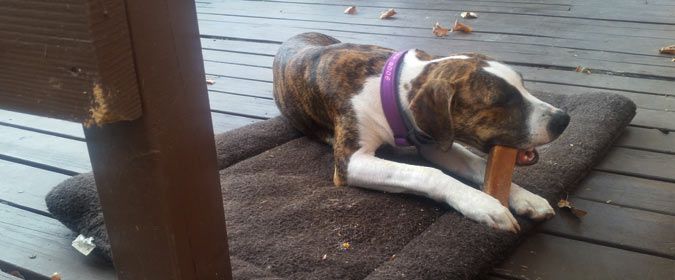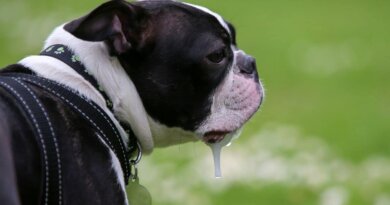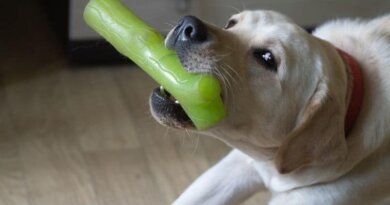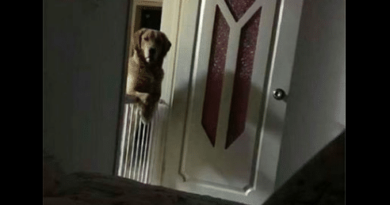Why Do Dogs Chew | Safe Dog Chew Toys
Recently, I was surprised and happy to receive some photos and a report from one of the families who adopted a puppy from the last litter I fostered for my local shelter. Predictably, their only complaint (if they could be said to complain about an already beloved member of the family) was his voracious appetite for chewing. Even the wood furniture was at risk, they said.

I had to laugh at that. When my dog Woody was a pup, he, too, was drawn to chewing on anything wood – and no, that’s not how he got his name. He was named when he was very small for his fantastic brindled coat, which looked like a gorgeous wood grain. When, a few months later, it developed that he was particularly drawn to chewing on anything made out of wood, it was just a bit of irony.
There are three main reasons why puppies chew:
- To explore the world (remember, they don’t have hands to use to pick up things),
- Because dogs have evolved as (mostly) carnivores who use their teeth to tear the flesh of prey animals and crack open bones to eat the marrow,
- And to relieve what we can only guess is a strange and unrelenting sensation in their gums, caused by the eruption of their many pointy teeth. When puppies are so drawn to chewing, we call this teething, because we’ve observed that human babies, too, seem to experience discomfort from the eruption of teeth.
Usually, all the dog’s adult teeth have erupted by the time he’s 7 months old (though small-breed dogs, with very crowded mouths, sometimes have retained deciduous teeth that need to be removed by a veterinarian). But as dogs continue to mature and grow, their skulls and jaws grow, too, so their teeth continue to shift and settle throughout their first year. The puppy teething experience seems to persist well into the dog’s second year.
Most puppies and adolescent dogs naturally chew. If you pass them an unfamiliar item with a novel texture, chances are they will take it and immediately lie down to give it a bit of a chew. Some dogs prefer hard items, some prefer to chew up soft things. Some are drawn to leather, some like plastic. As I said before, Woody went for wooden items, ranging from a cute wooden dog house that I thought he might enjoy hanging out in when in the yard, to our deck, furniture, and even trees in the yard. The variation in chewing preferences is why we recommend making sure you have a variety of “legal” chew items for pups to explore; once you discover what textures they like to chew on most, you can get more of those things to occupy their time and teeth.

Everyone asks: What are the safest chews to give my puppy? The fact is, depending on their jaw strength and how much unsupervised time they have on their hands, or jaws, nothing is completely safe! Your job is to find items that they like to chew and that they cannot destroy too quickly, and to supervise them closely with these items. Some pups chew only to destroy, and swallow very little of what they are chewing up. Others swallow far too much of what they chew and can end up with intestinal obstructions or perforations (both are very bad things).
Take chew items away (permanently) if your pup can destroy them too quickly; while you always need to supervise, if the pup can’t be safely left with the item for a literal five minutes, with our attention-challenged days, it’s probably not safe enough for him to have at all! The same goes for items that are even remotely close enough to be swallowed whole. I take away chew sticks when they get close to six inches; that’s getting too small for comfort with any but the smallest puppies.
“Six inches?!” you may say. But half the stuff in the pet supply store is that size or less! Yes, I say, and I’m sorry. But I wouldn’t give 90% of what’s in pet supply stores to my puppies to chew.
Toys to chew on are easier to find than the animal-source chews that most dogs and puppies prefer. But animal-sourced chews are also the source of most chewing-related medical emergencies caused by puppies swallowing things they shouldn’t. People love to see dogs chomp up those dried (and brittle) pigs’ ears as if they were potato chips. I don’t! Those dried edges are sharp – and they get swallowed when still hard and sharp. And most rawhide chews or “bully sticks” (dried cattle penises) are sold in small sizes – far too easily swallowed.

I like to buy the most enormous chew items I can find, no matter what size the puppy is. In my experience, it’s best to find the largest fresh, raw, meaty bone you can find – something so huge that it’s impossible for your pup to get between his molars and break pieces off of. It’s difficult to find these! You may have to search high and low, asking local butchers if they can procure some for you. (Today, much of the meat supply is shipped to store already butchered and packaged; the shops that still cut up whole animal carcasses in their stores are in short supply.)
Until last year, I had a favorite source for giant, thick rawhide puppy chews – and it’s gone out of business. Rawhide is fraught with problems; it can be processed with toxic chemicals and contaminated with pathogenic bacteria. The one source I had used only American beef hides that were fresh from a slaughterhouse – not already treated hides from a tannery. Since that company went out of business, I’m not using any rawhide products! I haven’t found a safe alternative that I trust yet.
In the meantime, I look for rubbery alternatives that don’t come apart quickly even under the sharpest teeth. I have an Orbee Tuff toy made by Planet Dog that has lasted through at least four litters of foster puppies. The Zogoflex line of toys by West Paw is terrific. Recently, I found a line of natural rubber toys made by Indi Pets that I love.
There are lots of things you can do to direct your puppy and adolescent dog to appropriate chew items, and away from the apple trees and furniture. See these articles for help!
https://www.whole-dog-journal.com/puppies/pre_puppy_prep/take-control-of-puppy-chewing/





20 mg sildenafil 30 tablets cost: generic sildenafil nz generic sildenafil 20 mg cost